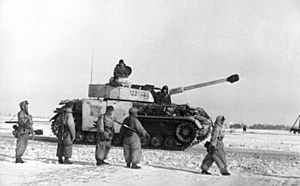| Kirovograd offensive | |||||||
|---|---|---|---|---|---|---|---|
 German troops and Panzer IV in Ukraine, January 1944 | |||||||
| |||||||
| Belligerents | |||||||
|
|
| ||||||
| Commanders and leaders | |||||||
| Ivan Konev | Otto Wöhler | ||||||
| Units involved | |||||||
| 2nd Ukrainian Front |
8th Army:[1] - XI Army Corps - XXXXVII Panzer Corps - LII Army Corps - GHQ units directly subordinated to the army | ||||||
| Strength | |||||||
|
1 January 1944:[2] - 550,000 personnel in total - 265 tanks - 127 self-propelled guns - 7,136 guns and mortars - 777 anti-aircraft guns - 500 combat aircraft |
Personnel strength on 31 December 1943:[3] - 260,000 personnel in total AFV status on 1 January 1944[4] Operational: - 110 tanks - 62 assault guns - 71 self-propelled AT guns and artillery pieces In short-term repair: - 132 tanks - 15 assault guns - 35 self-propelled AT guns and artillery pieces | ||||||
| Casualties and losses | |||||||
| Exact unknown | Exact unknown | ||||||
The Kirovograd offensive operation (Russian: Кировоградская наступательная операция, Ukrainian: Кіровогра́дська наступа́льна опера́ція),[5] known on the German side as The defensive battle in the Kirovograd area (Die Abwehrschlacht im Raum von Kirowograd),[6] was an offensive by the Red Army's 2nd Ukrainian Front against the German 8th Army of Army Group South in the area of Kirovograd in central Ukraine between 5 and 16 January 1944. It took place on the Eastern Front of World War II and was part of the wider Dnieper–Carpathian offensive, a Soviet attack against Army Group South that aimed to retake the rest of Ukraine west of the Dnieper river, which had been occupied by Germany in 1941.
- ^ Armee-Oberkommando 8, Ia. Anlage zu A.O.K. 8 Ia Nr. 24/44 g.Kdos. Kriegsgliederung der 8. Armee. Stand vom: 5.1.44. NARA T312, R64, F7582628.
- ^ Грылев А.Н. Днепр-Карпаты-Крым. Освобождение Правобережной Украины и Крыма в 1944 году. Москва: Наука, 1970, p. 49.
- ^ Anlagenband zum Kriegstagebuch, A.O.K. 8, Oberquartiermeister, 1.1.44.-31.3.44. Anlage 1 zu Armeeoberkommando 8/O.Qu./Qu.1 Nr. B Nr. 15/44 geh. v. 4.1.44. Betr.: Verpflegungsstärken nach dem Stande vom 31.12.43. NARA T312, R63, F7581006.
- ^ Monthly condition reports (Monatliche Zustandsberichte), showing the AFV status (Panzer, StuG, self-propelled AT guns and artillery pieces) of all units belonging to the A.O.K. 8, as of 1 January 1944. Compilation based on numerous primary sources:
Bundesarchiv-Militärarchiv (BA-MA) RH 10/61, 142, 149, 151, 152, 180, 209, 316, 332. - ^ Грылев А.Н. Днепр-Карпаты-Крым. Освобождение Правобережной Украины и Крыма в 1944 году. Москва: Наука, 1970, p. 48.
- ^ Unterlagen der Ia-Abteilung des AOK 8: Beschreibung der Abwehrschlacht im Raum Kirowograd, 5.-17.1.1944. TsAMO, fu. 500, inv. 12470, f. 5, p. 1.